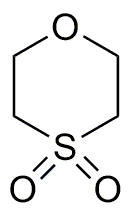4,4-Dioxo-1,4-oxathiane is widely utilized in research focused on:
- Pharmaceutical Development: This compound serves as a key intermediate in synthesizing various pharmaceuticals, particularly in creating drugs that target specific diseases due to its unique chemical structure.
- Polymer Chemistry: It is employed in the production of specialty polymers, enhancing material properties such as durability and resistance to environmental factors, making it valuable in the manufacturing of advanced materials.
- Analytical Chemistry: Used as a reagent in analytical methods, it helps in the detection and quantification of other compounds, providing researchers with reliable results in chemical analysis.
- Environmental Science: The compound is explored for its potential in environmental applications, such as in the degradation of pollutants, contributing to cleaner ecosystems and sustainable practices.
- Food Industry: It finds applications as a food preservative, helping to extend shelf life while maintaining safety and quality, which is crucial for food manufacturers and consumers alike.
General Information
Properties
Safety and Regulations
Applications
4,4-Dioxo-1,4-oxathiane is widely utilized in research focused on:
- Pharmaceutical Development: This compound serves as a key intermediate in synthesizing various pharmaceuticals, particularly in creating drugs that target specific diseases due to its unique chemical structure.
- Polymer Chemistry: It is employed in the production of specialty polymers, enhancing material properties such as durability and resistance to environmental factors, making it valuable in the manufacturing of advanced materials.
- Analytical Chemistry: Used as a reagent in analytical methods, it helps in the detection and quantification of other compounds, providing researchers with reliable results in chemical analysis.
- Environmental Science: The compound is explored for its potential in environmental applications, such as in the degradation of pollutants, contributing to cleaner ecosystems and sustainable practices.
- Food Industry: It finds applications as a food preservative, helping to extend shelf life while maintaining safety and quality, which is crucial for food manufacturers and consumers alike.
Documents
Safety Data Sheets (SDS)
The SDS provides comprehensive safety information on handling, storage, and disposal of the product.
Product Specification (PS)
The PS provides a comprehensive breakdown of the product’s properties, including chemical composition, physical state, purity, and storage requirements. It also details acceptable quality ranges and the product's intended applications.
Certificates of Analysis (COA)
Search for Certificates of Analysis (COA) by entering the products Lot Number. Lot and Batch Numbers can be found on a product’s label following the words ‘Lot’ or ‘Batch’.
Numéro de catalogue
Numéro de lot/série
Certificates Of Origin (COO)
This COO confirms the country where the product was manufactured, and also details the materials and components used in it and whether it is derived from natural, synthetic, or other specific sources. This certificate may be required for customs, trade, and regulatory compliance.
Numéro de catalogue
Numéro de lot/série
Safety Data Sheets (SDS)
The SDS provides comprehensive safety information on handling, storage, and disposal of the product.
DownloadProduct Specification (PS)
The PS provides a comprehensive breakdown of the product’s properties, including chemical composition, physical state, purity, and storage requirements. It also details acceptable quality ranges and the product's intended applications.
DownloadCertificates of Analysis (COA)
Search for Certificates of Analysis (COA) by entering the products Lot Number. Lot and Batch Numbers can be found on a product’s label following the words ‘Lot’ or ‘Batch’.
Numéro de catalogue
Numéro de lot/série
Certificates Of Origin (COO)
This COO confirms the country where the product was manufactured, and also details the materials and components used in it and whether it is derived from natural, synthetic, or other specific sources. This certificate may be required for customs, trade, and regulatory compliance.


